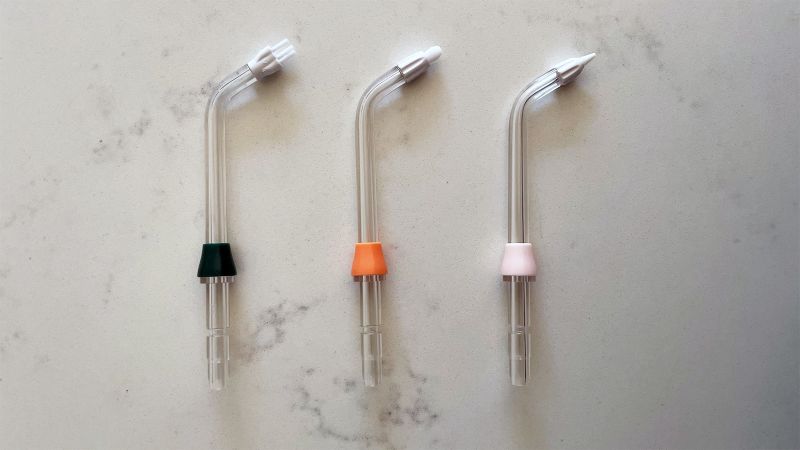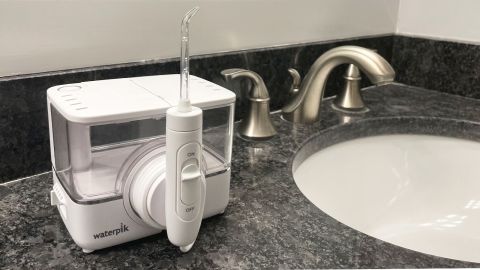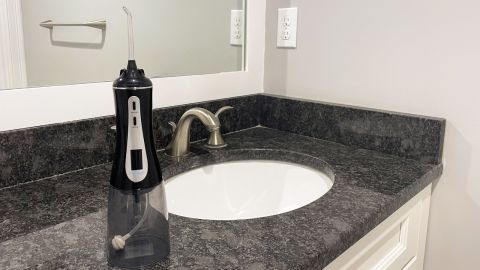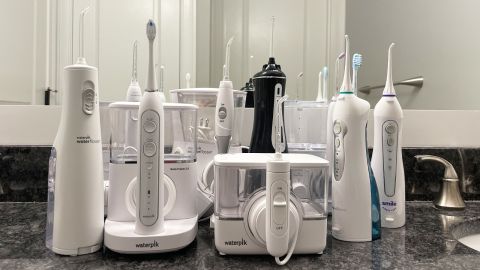
A water flosser makes taking care of your teeth and gums easier — and we’ve found the best ones

There’s no sugarcoating it — oral health is incredibly important. And while brushing your teeth is the top activity you should be embarking on every morning and night, there’s more you can truly do to take care of your pearly whites. Water flossers, also known as oral irrigators, are handheld devices that serve as an extra way to clean between your teeth, in areas where your toothbrush can’t reach. With a stream of water sprayed along the gum line and teeth, any excess food and bacteria can be removed.
To find the best water flosser, we tested nine different models across a few different brands. We incorporated water flossing into our daily oral care regime and observed every feature each water flosser had to offer. After a few weeks of rigorous flossing, we found two that were our ultimate favorites.
The best water flosser overall
This full-featured cordless flosser takes up little space on the counter, but has a big reservoir that keeps you flossing — plus it was a pleasure to use in our testing
The best water flosser for travel
A big battery and reservoir, along with fully waterproof construction, make this a perfect travel companion. It’s easy to use and maneuver, and just as easy to pack away.

This Waterpik Ion Water Flosser is the only cordless countertop water flosser we tested. It has a large reservoir like corded units, but the compact footprint and rechargeable battery let you place it anywhere — a design that we truly appreciated, and one we’d recommend regardless of how much counter space you have in your bathroom. We were able to place the unit anywhere without having to worry about access to a plug, especially since the battery lasts up to four weeks at a charge.
More importantly, the Ion is a pleasure to use, courtesy of a 360-degree rotating nozzle handle. In our testing, we found that rotating the nozzle is incredibly easy, even while you’re flossing. Having this option helps you position the water more accurately and can be very beneficial, especially if you have any orthodontic appliances. It came in especially handy when flossing the inside of our upper teeth — an area that’s hard to reach and easy to miss. The ION’s handle is also magnetic, making it effortless to snap onto the base when it’s time to put it away.
Controlling the Ion is simple, with 10 different pressure settings accessible using a dial on the side of the base. There are no specialized pulse or massage modes, which we didn’t personally miss and didn’t count as an oversight.
Seven nozzle types are included with the ION: you get two regular jet tips with color-coded bands so you can share the unit with a partner, along with an implant denture tip, orthodontic tip, “pik pocket” tip, “plaque seeker” tip and tongue cleaner. While some of these extra nozzles aren’t necessary for most people, we often used the tongue cleaner to remove bacteria buildup for fresh breath. And even though the plaque seeker tip is intended for with those with implants, crowns and bridges — which we don’t have — we enjoyed this particular nozzle as it felt as though it was giving our gums an extra cleaning. With the many nozzle options, regardless of your dental needs, you’ll find an appropriate tip to lead you on the right path for successful oral hygiene. The Ion is the only flosser we tested that offers a tip meant for cleaning fixed implant bridges and dentures. There’s also a plastic case to store all of the extra nozzles.
The ION’s compact design also helps make it easy to place. It isn’t nearly as tall or wide as many of the countertop water flossers we tested, but even with a smaller footprint, it doesn’t sacrifice reservoir size and can hold a generous 600mL of water, which is among the largest we tested. The other countertop water flossers we tested had reservoirs that ranged from 400mL to 600mL. With the large tank size, it’s enough water to floss at any pressure setting without having to refill. The compact design also gives it a cleaner look on the countertop.
With this flosser, you’ll also notice a 30- and 60-second pulse timer, which acts as a reminder to move to another section of the mouth. We only found this on two others we tested — which happen to be Waterpik products — and it’s definitely nice to have. We appreciated it in our tests of the best electric toothbrush, and found it a similarly useful reminder on the flosser.
Ultimately, we were extremely impressed with this water flosser. Between the compact design, ease of use and overall effectiveness, this is a water flosser that can work well in most bathroom spaces — while also keeping your teeth clean.

If you are looking for a water flosser you can take with you, then the MySmile Cordless Oral Irrigator is by far the best around. On a full charge, this cordless flosser lasts approximately 15 days, and a provided travel bag makes it easy to pack. And since the water flosser is small enough to fit in a typical shower caddy and is fully waterproof, you can even keep it in the shower for a few weeks at a time, for those who find flossing in the shower easier and less messy. Registered dental hygienist Nicole Barbour, who works for a dental practice in Newton, Massachusetts, even suggests flossing in the shower as it “resolves the complaint about the water flossing mess and makes the habit [of water flossing] much easier to develop.”
Although the MySmile Cordless Water Flosser is compact, it doesn’t skimp on tank size. With a 350mL reservoir, it’s twice the size of the other portable water flossers we tested. This allows most consumers to complete a full flossing session without needing to refill the tank — something that you might have to do with many other portable flossers.
The flosser also features a digital display showing the setting, water temperature, water quality and battery life — a feature that we only encountered on this water flosser. While we thought the battery life indicator was useful to know when we’d need to charge again, we personally didn’t find much value in the water information. However, if you have sensitive teeth or are in an area where water quality might not be safe, then having the information at hand could be beneficial. Additionally, with the smart memory capability, the setting selected — either soft, child, strong, normal or pulse — will stay the same the next time you use the flosser. Four of these modes act as your pressure setting, where the pulse mode ultimately pulses water into your mouth, instead of a constant jet stream.
We also found the flosser incredibly easy to use and maneuver. And to actually get the water flowing, you have to press the on/off button twice, a feature we greatly appreciated. This reduced the number of times that we accidentally turned the flosser on and caused a water mess around the bathroom — which happened quite often with many other portable flossers. The 360-degree rotating nozzle was also one of the easiest to use and made flossing around our entire mouth much easier without having to turn the handle in a different direction. For those with braces or other orthodontic appliances, this should come in incredibly handy.
This flosser also offered the most nozzles out of any of the flossers we tested, with a total of eight attachments: four regular jet tips (including one for high pressure and one for low pressure), a pik pocket tip, a plaque seeker tip, an orthodontic tip and a tongue cleaner. Although we didn’t notice much of a difference between the regular jet tips, having multiples is nice, even if it just allows you to not have to purchase replacements for awhile.
With a compact and portable design, a large water tank, a variety of nozzles and a handful of pressure settings, it’s no surprise that this one truly beats all of the other portable options out of the park.
The American Dental Association (ADA) advises that the “use of an interdental cleaner (like floss) is an essential part of taking care of your teeth and gums.” But the organization doesn’t recommend any particular method of interdental cleaning, pointing to a 2019 review of the literature on the topic by Cochrane Oral Health that found the evidence for the effectiveness of water flossers (or “oral irrigators”) was “limited and inconsistent”
Research and innovation continue in the area, however, with several varieties of interdental cleaners gaining popularity over string floss with dental professionals (who, like the ADA, are often just trying to get people to pay attention to interdental cleaning at all more than arguing for the efficacy of any tool), including interdental brushes, wooden and rubber tooth-cleaning sticks, and, of course water flossers, which replace (or augment) a physical cleaner with a stream of water.
Like traditional flossing, the goal of water flossing is to remove food and bacteria in places your toothbrush can’t reach — between your teeth, at the gum line, in areas concealed by orthodontic appliances or dentures and so on. This ultimately reduces plaque in your mouth as well as the risk of cavities, gum disease and tooth decay.
Many water flosser brands claim that water flossing “removes up to 99.9% of plaque from treated areas.” Waterpik points to a large number of studies supporting the claim water flossing is more effective than traditional methods, including one that suggests water flossing is significantly better than string flossing for plaque removal and an improvement over interdental brushes with regard to overall gingival health. Philips has publicized research suggesting the same, including a study demonstrating similar results with regard to plaque removal. A team at BioSci Research Canada has found evidence that when combined with a manual toothbrush, a water flosser is significantly more effective than string floss in removing plaque from tooth surfaces (this study was performed with a Waterpik water flosser).
That said, the majority of these studies have been small and there is no clear consensus on which approach is best. The dentists and hygienists we spoke to told us that water flossing isn’t a replacement for brushing and shouldn’t replace string flossing. Rather they suggest that water flossing is great for people with dexterity issues, orthodontic work and even periodontal disease — all of which can make string flossing or interdental brushing difficult, uncomfortable or painful. Barbour told us that her ideal scenario is for “every patient to [string] floss nightly and then use a water flosser as an adjunct to flossing.”
When using a water flosser, you’ll want to fill the water flosser’s tank with lukewarm water — a recommendation given by most brands, especially for those with sensitive teeth or gums, and something we found more comfortable in our personal experience. To reduce a water mess in your bathroom, make sure you are leaning over the sink and put the nozzle in your mouth first, prior to turning on the water flosser. Or, if you have a portable water flosser, many are waterproof, allowing you to floss in the shower.
Just like brushing your teeth, you’ll want to ensure to floss throughout your entire mouth. This includes the top and bottom, back and front. You’ll want to floss along the gum line and in between each tooth.
But like most products on the market, there are many water flossers to choose from. While we found they all got gunk out of our teeth, some are easier to use than others and offer extra settings or nozzles for a better clean, especially for people with specific dental needs. There’s also a wide range of features and accessories between products. So before you purchase your next water flosser, here are the main features to consider.
Size and power source
Based on our personal experience, we suggest you pay careful attention to the size of the unit. Countertop water flossers are significantly larger than portable ones and typically need to be plugged in (although there are a few countertop cordless options). Taking your countertop space into consideration will help you determine whether a countertop or portable flosser is right for you.
But even if you have a large countertop, you need to determine the location of your wall plug. Having a corded water flosser far away from a plug means you have long cords wrapped around your countertop, which isn’t ideal.
You’ll also want to take into consideration whether or not you’ll want to travel with your water flosser or even take it into the shower with you. For these scenarios, we found that a cordless portable option — one that is also waterproof — to be a great option.
The reservoir tank holds the water used while water flossing. The amount of water the tank can hold has a direct impact on how long you can floss without it being refilled. The flossers we tested had reservoirs ranging from 175mL to 600mL in size; we found that a tank size of 350mL or more can typically last for an entire flossing session, though the pressure setting and mode used can also affect the amount of water used.
Pressure settings and modes
Most water flossers offer multiple pressure settings and modes. We found that most countertop flossers offer 10 different settings, while the portable options have just a handful. The average user will only need a few settings; however, there are few situations where you’ll want to ensure you are using a specific pressure option.
Barbour informed us that many patients, especially those with gingivitis, may experience discomfort when first using a water flosser. For these patients, starting on a low setting is preferrable. But as the “gums heal and inflammation decreases, a higher setting may not only be better tolerated, but also offer better reach under tighter gingival margins.” Many of the products also suggest starting on a lower setting and then working your way up to a setting that feels most comfortable. A higher setting can also come in handy if you are looking for a quick blast between your teeth where food is lodged in between.
In addition to pressure settings, some water flossers offer a pulsing or massage feature where the stream of water is pulsating out of the nozzle. According to Waterpik, this helps stimulate the gums and can help remove loose plaque from below the gumline — a useful option for patients with receding gum lines and periodontal disease. Philips suggests that all modes on today’s water flossers provide roughly equivalent cleaning; additional pulse and massage modes are meant to increase comfort for those who can’t tolerate a direct stream, making it more likely that they will continue flossing.
Barbour told us that she feels massage mode has an effect similar to traditional rubber-tip gum stimulator, and while she can see the rationale in including this feature on a water flosser she “hasn’t seen a body of independent research to prove whether this feature is actually effective or necessary.”

All water flossers come with a classic jet tip, which works like a pressure washer, producing a stronger stream by virtue of forcing water through a small opening, Philips supplies a “Quad Stream” tip, which is meant to cover a larger surface area with each pass, giving users more of a chance to remove buildup. (They’ve demonstrated the effect on artificial surfaces, where it removes the great majority of biofilm; in the mouth, Philips claims that the Quad Stream tip is up to 180% more effective than string floss in promoting healthier gums in users with moderate to severe gingivitis.)
Many of the flossers we tested come with extra specialized nozzles that are beneficial for certain users. It’s important to speak to your dentist about your particular needs, and none of these nozzles are meant to be used on their own. Rather, they should be used in specific areas while a general-use tip is used to clean the rest of the mouth. And in no case is any tip meant to replace toothbrushing.
“Plaque seeker” and “dental implant” tips are meant to get into and remove plaque from difficult-to-reach spaces around implants, crowns, bridgers and retainers — space where, Barbour told us, “maintaining periodontal health and attachment levels around implants is critical.” Waterpik’s plaque seeker tip is covered with soft bristles that can gently and safely be placed against the gumline. Barbour also recommends this tip for beginners who “haven’t used a water flosser before and might have some trepidation about being able to properly adapt to one.” We agree after testing, and particularly liked the gentle feel.
Orthodontic tips are similar, designed for removing food and plaque from underneath wires and around brackets and bands. Barbour told us that this type of nozzle is “helpful to remove the plethora of food and plaque that accumulates around braces, especially since it can be difficult to thoroughly clean with a toothbrush.”
The soft rubber pik pocket tip is meant for people dealing with periodontitis who have developed periodontal pockets. Meant to be used with the lowest pressure settings, these small, soft rubber tips can reach into the space between the tooth and gum, an area impossible to reach with string floss and a challenge for any other interdental cleaner.

To help find the best options, we selected nine popular water flossers. Over a three-week timeframe, we tested each water flosser during our normal brushing routine, brushing our teeth with an electric toothbrush and then using the water flosser. We also used the flosser after many meals when we could feel food stuck in between our teeth.
After squirting water in our mouth an excessive amount of times, we examined every feature and assessed each water flosser in the following categories.
We analyzed how each water flosser is charged — whether it needs to be plugged in while in use or cordless powered by batteries or a rechargeable option.
We also tested to see how easy it was to fill each reservoir to the maximum amount of water possible, ensuring no water splattered on our countertop along the way. During this process, we also measured the water reservoir to see how much water it could hold, as this has a direct impact on how long one can floss their teeth without having to refill with water.
We examined the size (width and height) of each water flosser and the amount of counter space it takes up.
We also assessed the overall look and feel of the water flosser, particularly how easy was it to hold the handle with the nozzle at a 90-degree angle against the gumline (which is the recommended stance). We also determined whether or not the nozzle holder rotates, allowing the flosser to move around the mouth in a simpler manner.
We assessed whether or not the water flosser offered multiple pressure settings, different modes and a variety of nozzles. We also utilized the various settings, modes and nozzles for each respective water flosser.
As we do with any household item, we looked into the warranty and satisfaction guarantee options. We also looked into whether or not the water flosser received an ADA Seal of Acceptance, awarded by the American Dental Association’s Council on Scientific Affairs after review by independent experts. Although we found that Waterpik and Philips are the only two brands to have received this approval, Barbour told us that she is comfortable with her patients using other brands.
The Philips Sonicare Power Flosser 7000 System is expensive, but it truly has it all — though perhaps more than you need in one device. If you are looking for a corded countertop flosser with all of the bells and whistles and don’t already have an electric toothbrush you like, it might be worth looking into, but otherwise you might end up paying for more than what you actually need.
For starters, the base houses both a water flosser and an electric toothbrush charger. This allows you to keep all of your oral hygiene needs in one space, with the combined design taking up less counter space. It also uses just one outlet, which could be beneficial for some. However, if you don’t need the toothbrush component, there’s also the Philips Sonicare Power Flosser 3000, a stand-alone water flosser with the exact same features.
The water flosser offers 10 different pressure settings with four different modes: clean, deep clean, sensitive and massage. We felt as though the differences were extremely subtle and not a huge selling point for the flosser. We also found that the water flow with the clean mode was slightly shaky and didn’t give us the consistent stream of water that we found with most of the other flossers we tested. The deep clean and sensitive mode also offer what Philips calls pulse wave technology, where a subtle pulse is used as an indicator to move from one tooth to another. Unfortunately, we preferred the feeling of the water flow from many of the other flossers tested.
In addition to the standard nozzle, the Philips Sonicare Power Flosser 7000 comes with a comfort nozzle and quad stream nozzle — both with soft rubber tips, which gave a gentle feel along the gums and were completely different than any other nozzles we tested. The comfort nozzle is otherwise like a traditional jet tip, while the quad stream nozzle has an X-shaped opening, so the stream covers a larger surface area. In your mouth, it feels as though four jets are cleaning your teeth at once. While we can’t confidently say that this in fact cleaned our teeth any better, we could feel the increase in coverage along our teeth and gums, and we truly preferred the experience over the regular jet tip.
The water flosser also offers a 600mL reservoir and a magnetic nozzle holder. On the downside, the nozzle doesn’t rotate, a feature we found to be helpful while flossing with other models.
The Philips Sonicare Power Flosser 3000 is very similar to the 7000 version, but with a few key differences, the main one being that there’s no electric toothbrush component. With its lower price point, there are some features that are missing, but we felt after testing that this was the better value of the two.
The look and feel is very similar, where you’ll have access to 10 different pressure settings, although the reservoir only holds up to 550mL of water (which is still large enough). And instead of four modes, only two are offered — clean and deep clean. We felt as though these two modes are more than sufficient, especially since we couldn’t feel a big difference between the four anyways during our testing.
The Philips Sonicare Power Flosser 3000 also comes with the quad stream nozzle, which covers a wider surface are and is a big selling point in the Philips Sonicare lineup of water flossers. You’ll also find the same two-year warranty and pulse wave technology.
If we were to narrow down our purchase to either the Philips Sonicare Power Flosser 3000 and Philips Sonicare Power Flosser 7000, we’d pick the 3000 version. We found that the extra features on the 7000 version aren’t worth the price difference for most consumers, and many people have already adopted electric toothbrushes. But if you’re looking for a water flosser and toothbrush combination, then the 7000 system is a better option.
The Waterpik Aquarius Water Flosser comes with seven different flossing nozzles (three regular jet tips, a plaque seeker tip, pik pocket tip, toothbrush tip and orthodontic tip), making it ideal if a speciality tip is a necessity for your oral needs. It is also the only water flosser we tested that offers a toothbrush tip, which you can use as you would a manual toothbrush, with or without toothpaste.
The covered tank can hold 600mL of water, which during our testing lasted us around 90 seconds on the highest setting and over 4 minutes on the lowest setting, leaving you with more than enough water to complete your flossing session without having to refill the water tank.
On the base, there’s an easy-to-use dial that offers 10 different pressure settings. You can set your pressure prior to flossing, while also turning it up or down during the process. In addition to the standard flossing mode, there’s also a “massage” mode where you’ll find a pulsing stream of water. With the regular flossing setting, there’s also a 30-second pulsar reminding you to move from one half of your mouth to the other ensuring you spend enough time flossing each section.
The design is very well thought out with an on/off switch on the handle as well as a power button on the base. The nozzle also rotates a complete 360 degrees and is fairly easy to move even while in the midst of flossing. A unique feature to this water flosser is that the base can store up to two nozzles, which gives you easy access to commonly used nozzles without having to fish through your bathroom drawers. It also offers an extended three-year warranty, which is longer than most of the water flossers we tested.
The one major downside to this water flosser is the size. As a corded flosser, it’s both wide and tall, which ultimately takes up a decent amount of space on the countertop. If you have a smaller counter space, or not enough counter space near an electrical outlet, this could be a deterrent to purchasing this particular flosser.
The Waterpik Sonic Fusion 2.0 is a two-in-one unit, but instead of providing a separate flosser and toothbrush like the Philips Sonicare 7000, it incorporates the two functions into one unit. When you want to floss, the water streams from a hole in the center of the toothbrush. With this design, you can floss, brush your teeth or — theoretically — floss and brush at the same time.
Despite the ingenuity of this all-in-one concept, the act of flossing with this toothbrush/flosser was not our favorite. Since a toothbrush head is much larger than a water flosser tip, we felt as though we couldn’t keep our mouth closed enough, thus resulting in a bigger mess on our counter.
We also had a harder time angling the water to hit the gum line correctly. And while the Sonic Fusion 2.0 does offer 10 different pressure settings, we found that the pressure needed to be turned up high to feel as though it was working — which could be too abrasive for some.
But if you’re looking for a two-in-one contraption, the flosser offers two different toothbrush heads (one compact, one full-size), a 30-second pulsar, a 400mL water tank and a three-year warranty.
Waterpik also makes a cordless water flosser, allowing you to easily take the flosser with you on the go or even into the shower with you due to its waterproof design. Since water flossing tends to make a decent amount of mess in the bathroom, flossing in the shower can make for a cleaner experience. However, with the Waterpik Cordless Express Water Flosser reservoir only holding 175mL of water, you might find that you’ll run out of water quickly and need to refill. During our testing, we found that we were able to get about 30 to 45 seconds of flossing depending on the setting. There are also only two setting choices and we found that the two settings weren’t as soft or strong as some of the other flossers we tested, which offer more pressure options. If you have sensitive teeth or are looking for an extremely strong blast of water, you might not find the pressure ideal for your needs.
Unlike most of the other flossers we tested, this one runs on three AAA batteries. This allows you to use rechargeables (and have extra power on hand instantly if you run out of charge unexpectedly), though it’s worth keeping in mind if you don’t want to deal with removable batteries. It’s also the only handheld water flosser we tested that doesn’t offer a rotating nozzle, a feature which some might find handy.
While this one wasn’t our favorite due to the lack of features that some other flossers have, if you are looking for a basic water flosser that ultimately gets the job done, this is the least expensive water flosser we tested. It’s also the only portable water flosser we tested that has received the ADA Seal of Acceptance.
The cordless Aquasonic Aqua Flosser is the most compact flosser we tested, although as a downside, it only contains a 175mL water reservoir. In the box, you’ll find four standard jet tips, each with its own color-coded band. Whether you are sharing the flosser amongst multiple family members or it’s a purchase just for yourself, this will give you plenty of spare nozzles without having to purchase any more for quite some time. This water flosser also comes with a storage bag, making it easy to take with you when traveling.
There are three different settings — normal, soft and pulse — which can be selected prior to starting the flossing session or even changed mid-session. That said, while flossing, we always noticed a slight pulsing, even on the two non-pulsing mode options.
And while the flosser offers a 360-degree rotating tip, we found it difficult to rotate while in the act of flossing. While flossing still got the gunk out of our teeth, the flosser had a cheaper look and feel to it.
Although not our favorite of the bunch (we think overall the MySmile is worth the additional expense if you want a cordless travel water flosser), the Aquasonic Aqua Flosser is compact and inexpensive and will get the job done.
The Smile Direct Club Wordless Water Flosser is almost identical to the Aquasonic Aqua Flosser, with the same flosser nozzles and modes offered. This cordless flosser also utilizes the same exact charging mechanism with a USB type-C cord and wall charger.
The main difference is that you’ll only receive two color-coded jet tips, instead of four, and no travel bag. It is slightly less expensive than the Aquasonic Aqua Flosser, so whether you choose one over the other should come down to whether or not the excess parts are worth the price difference for your particular needs.
Source: https://www.cnn.com/cnn-underscored/reviews/best-water-flossers?iid=CNNUnderscoredHPcontainer

















